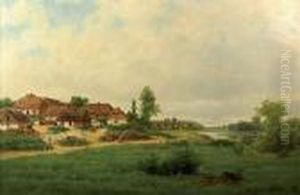Paul Ludwig Kowalczewski Paintings
Paul Ludwig Kowalczewski was a German sculptor born in 1865 in Minusio, Switzerland. He is often associated with the Berlin Secession movement, which was a part of the larger secessionist trend in European art at the turn of the 20th century. Secessionist artists sought to break away from the academic standards of the time, championing more individualistic and often modern approaches to art. Kowalczewski’s work was known for its elegant and often sensual depictions of mythological figures, nymphs, and allegorical subjects.
Kowalczewski studied at the Berlin Academy of Art, where he honed his skills in sculpture. He was deeply influenced by the prevailing artistic movements of his time, including Art Nouveau and Symbolism. His sculptures often featured flowing lines, natural forms, and an attention to detail that reflected the Art Nouveau aesthetic. Despite not being as widely known as some of his contemporaries, Kowalczewski contributed significantly to the landscape of German sculpture with his distinctive style and thematic focus.
Throughout his career, Kowalczewski received several commissions for public monuments and sculptures. However, much of his work was designed for a smaller scale, intended for private collections. His pieces were often cast in bronze, a medium that allowed for the fine detailing and textural contrasts that characterize his work.
Unfortunately, Kowalczewski’s career was cut short when he died in 1910 at the age of 45. The exact circumstances of his death are not widely documented, which is reflective of the relatively modest level of fame he achieved during his lifetime. Despite this, his sculptures still exist in collections and museums, and they continue to be appreciated for their craftsmanship and artistic value.
Kowalczewski’s legacy is one of a skilled sculptor who contributed to the rich tapestry of European art during a period of significant change and experimentation. While his name may not be as celebrated as some of his peers, his work remains a testament to the creativity and innovation of the Berlin Secession movement and the broader Art Nouveau period.
